-
Membership
Membership
Anyone with an interest in the history of the built environment is welcome to join the Society of Architectural Historians -
Conferences
Conferences
SAH Annual International Conferences bring members together for scholarly exchange and networking -
Publications
Publications
Through print and digital publications, SAH documents the history of the built environment and disseminates scholarship -
Programs
Programs
SAH promotes meaningful engagement with the history of the built environment through its programs -
Jobs & Opportunities
Jobs & Opportunities
SAH provides resources, fellowships, and grants to help further your career and professional life -
Support
Support
We invite you to support the educational mission of SAH by making a gift, becoming a member, or volunteering -
About
About
SAH promotes the study, interpretation, and conservation of the built environment worldwide for the benefit of all
Croatia at the Crossroads of Time and Space Report
Oct 9, 2014
by
Ana Mitrovici
Sarajevo – Tuesday, August 19
Officially the start of the trip, participants arrived according to their own schedules, enjoying a few hours of leisure time before our welcome dinner at the Hotel Europe in the heart of the old town. Our arrival and stay in Sarajevo coincided with the Sarajevo film festival, giving the city a lively immediacy. I took the opportunity to explore the winding streets filled with shops in the Stari Grad, or old quarter, and familiarize myself with my new surroundings.
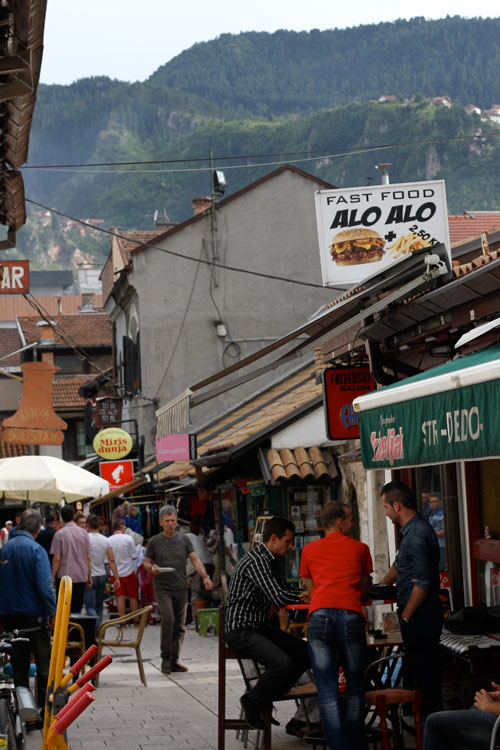
A lively side street in the old town of Sarajevo.
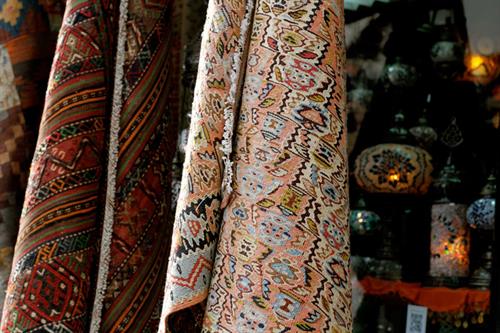
Carpets and lanterns in one of the many shops in the old quarter.
In the evening we gathered together in the lobby before dinner, getting to know each other or greeting friends from past trips. At dinner, our trip leader and lecturer, Boris Srdar, and SAH 1st Vice President, Ken Oshima, gave us an introduction to complicated and intertwining histories of the regions we would visit on our tour. Over a buffet dinner, we had the chance to enjoy some first previews of local recipes we would later seek out with enthusiasm over the next few days.
Sarajevo – Wednesday, August 20
We began the first morning bright and early with energy and excitement. We boarded the bus and headed through the crowded streets of Sarajevo to our first stop, a scenic overlook of the city. In order to get our bearings and familiarize ourselves with the layout of the city, the group took turns peering over the edge, seeing our first few glimpses of some of the significant sites we would visit later that day. With our guide Zijo Jusufovic, we headed to our next brief stop, the Vraca Memorial Museum begun in 1980 as a site commemorating lives lost in the Second World War. Today the park no longer represents a central site of the city, but rather a modern ruin with lush green overgrowth wrapped in the melancholic atmosphere of all forgotten landscapes.
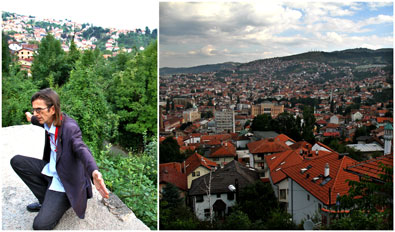
Our guide Zijo alerting us about the overlook’s edge and our view.
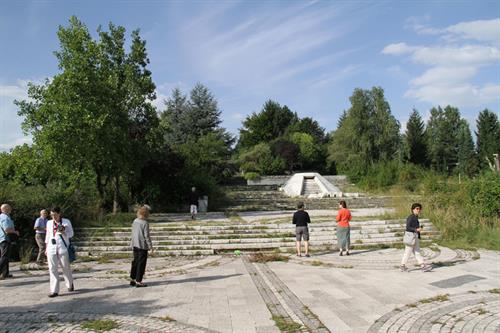
Exploring the Vraca Memorial site.
We boarded again and headed outside of the city to visit the site of the Sarajevo Tunnel, located near Sarajevo’s airport. We entered through its northern entrance, a house now converted into a museum with objects from the war period. The tunnel was first built between 1992 and 1995 as a way to bring supplies into the city of Sarajevo during its siege. Without question among the most somber moments of the trip, we watched a video with archival war footage and climbed down through a twenty-five meter portion of the tunnel that remains open to the public today.
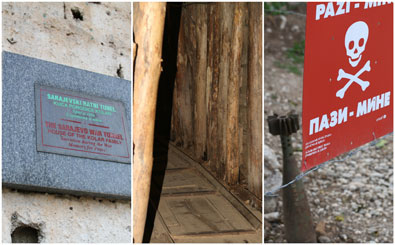
The Sarajevo Tunnel Museum entrance and site.
After a short refreshment break at the Hotel Casa Grande, the group returned to the city to visit the Historical Museum of Bosnia and Herzegovina, formerly known as the Museum of Revolution and designed by Edo Šmidihen, Radovan Horvat and Boris Magaš between 1958-1963. Today the museum continues to hold exhibitions and has a library and archive.
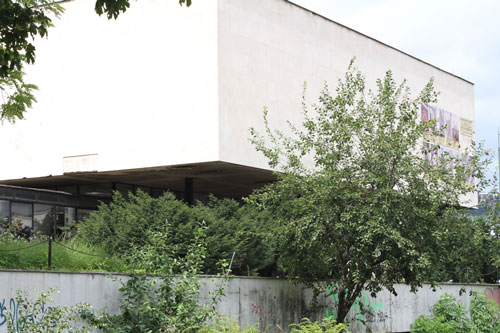
Historical Museum of Bosnia and Herzegovina.
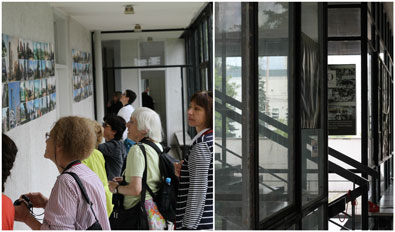
The group visiting an exhibit with a view of the interior of the Museum of Bosnia and Herzegovina.
The group boarded the bus and headed towards the National and University Library, passing the Olympic Stadium and home of the 1984 Olympics. We enjoyed a photo opportunity at the Library, first built in 1894 by Karel Parik and Ciril Iveković. The library was destroyed during the siege of Sarajevo, resulting in immense losses to its collection and completely rebuilt and restored beginning in 1997 based on original architectural plans.
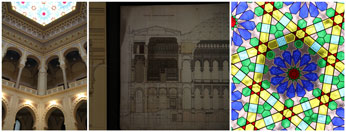
Details from the Library’s cupola, architectural plans, and the exquisite stained glass ceiling.
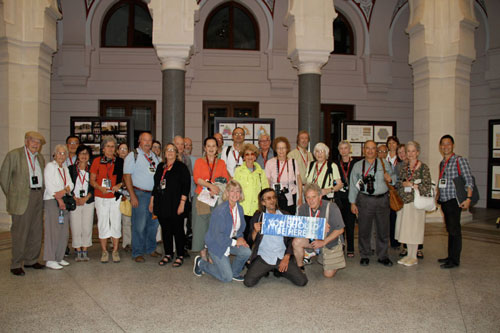
Everyone together in the Library.
The day was packed with sites and we continued our first day with a walking tour of Sarajevo. Our first stop was the Old Serbian Orthodox Church (St. Michael and Gabriel) with foundations dating back to the Middle-Ages. After a delicious and energizing lunch in the old quarter where we helped ourselves to more local cuisine, we continued along the busy streets on foot to the old quarter where we visited the courtyard of the Morica Han, once an inn for travelers beginning in the 16th century. We made our way to the Gazi Husrev-beg Mosque, built in the 16th century and financed by the Ottoman official of the same name who had then governed Bosnia. We visited the Kuršumli Madrasa, also known as the Gazi Hurev-beg Madrasa, also begun by the governor in 1537 as a school that remains in operation to this today.
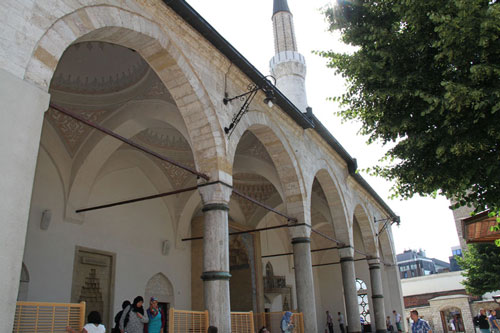
The Gazi Husrev-Bey Mosque, 16th century, exterior view.
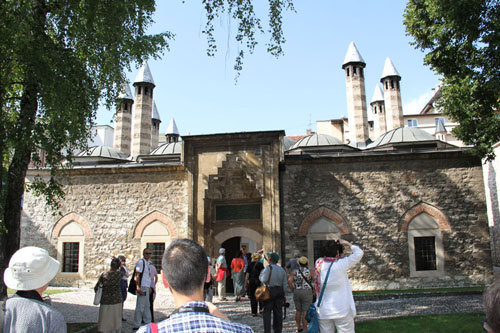
The Gazi- Husrev Madrasa, 16th century, exterior view.
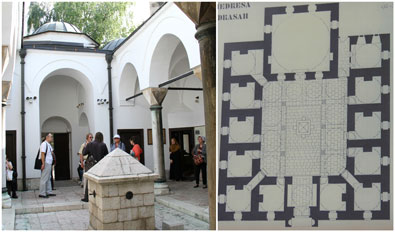
Interior view of the madrasa with ground plan.
Next we visited the Jewish museum and synagogue, built in 1581. The synagogue is a beautiful building with a softly lit stone interior, and we took our time exploring its quiet galleries. An enormous bound book suspended overhead from a long chain contains the names of the 12,000 victims who died in the Holocaust and stands as a reminder of the site’s significance but as a testament of its past, present, and future community.
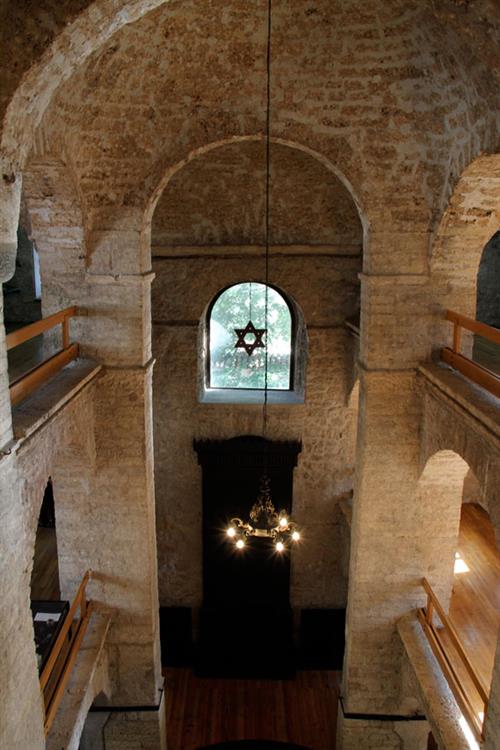
View from the gallery in the synagogue.
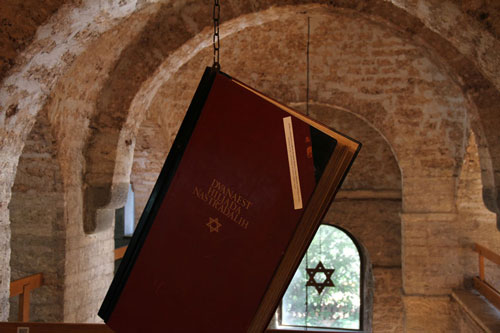
Book with the names of the lives lost in the Holocaust.
We then made a few short stops to a variety of works from different historical periods, first a contemporary structure, the Bosnian Center, then a residential apartment building dating from the post-war period, and finally the Despić House, a merchant’s house built in the late 19th century important for its cross-cultural interior that features a ground floor in the Ottoman style and an upper floor in the Austro-Hungarian style. The last official stop of the day was the street corner opposite the Latin Bridge and the infamous site of the assassination of Franz Ferdinand. As it happened, this year marked the one hundred year anniversary of the event.
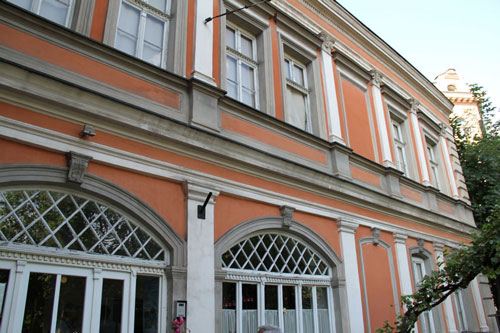
Exterior view of the Despić House.
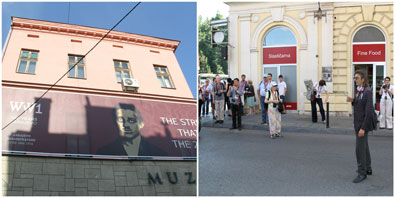
A view of the Museum, and our guide near the Latin Bridge, marking the site of the assassination of Franz Ferdinand.
While some returned to the hotels to refresh and prepare for dinner, a number of us powered through to see the immaculately restored Central Post Office designed by the architect Josip Vancas. We took in the space and Boris explained more about secession-style architecture. The night was capped off with a traditional (and I should add very generously portioned) meal at the restaurant Mala Basta where we shared in wonderful conversation and delightful cuisine. We returned to our hotel ready to rest up for the next busy day ahead.
Sarajevo/Mostar/Dubrovnik – Thursday, August 21
We began with an early morning wake-up and a day full of travel as we headed for one of the highlights of the tour, the UNESCO world-heritage site of Mostar, or Stari Most bridge and the surrounding area that had once served as an important node along trade routes. On the way we enjoyed the scenic views and made a quick stop at the restaurant Zdrava Voda, well-known for its cuisine. There, we marveled at the method of roasting lamb on spits powered by watermills.
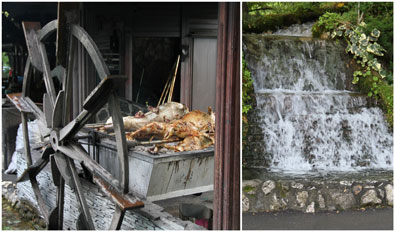
The restaurant Zrava Voda and the stream that powers their lamb roasting spits.
Our first stop for the day was an exquisite Turkish House in Mostar (Biščevića kuća) where we had the opportunity to learn more about the house’s design and history, the functions of its many rooms and the customs and traditions of its former owners. Its main gates opened to a beautiful pebbled courtyard with a refreshing fountain. Inside the house, one room rested on pillars and overlooked the courtyard while the men’s receiving room gave even more impressive views above the Neretva River.
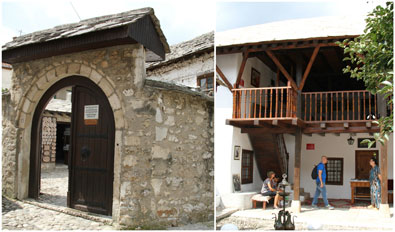
The entrance and inner courtyard of the Turkish House.
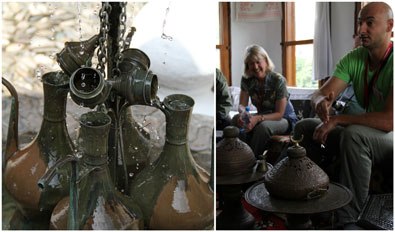
Details of the garden fountain and our guide explaining the customary coffee rituals of the house.
Our next stop was the magnificent Koski Mehmed Pasha Mosque dating to the 17th century, a beautifully decorated mosque situated near the Neretva River. We visited the mosque’s interior and its courtyard.
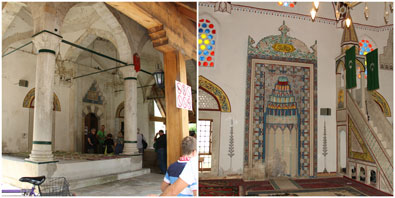
Entrance to the Koski Mehmed Pasha Mosque, 17th century and interior.
After some photo opportunities, our guide showed us the way to the most magnificent views of Mostar Bridge, first built in the 16th century and boasting a span of 28 meters and a height of 20 meters. The bridge was destroyed in 1993 and its reconstruction completed in 2004. Following our viewing of the bridge, we crossed it at our own pace, stopping along the way at the many shops and taking in the views from either side of the bridge.
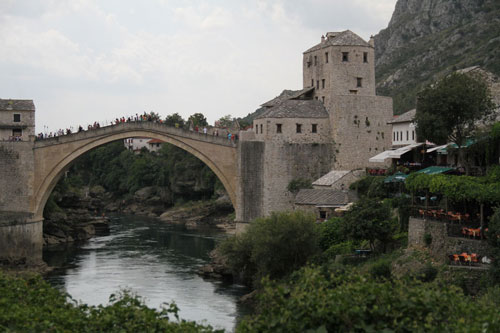
The Mostar Bridge, a UNESCO World Heritage Site.
We were reminded just how powerful the forces of nature can be when we were caught in a strong downpour following lunch and ran for the cover of our coach bus. We headed for the Archeological Museum of Narona in Vid, enjoying the scenery and drying off. Arriving in Vid, we explored the museum at our own pace and considered the juxtaposition of ancient material with the contemporary designs of the museum structure proper, built in 2007 by the architect Goran Rako. We continued a lively discussion on the bus, where we shared our personal impressions with respect to the design of the building and how well it integrated and related to the ancient material it housed. We headed for Dubrovnik and were rewarded for our fortitude in the face of inclement weather with views of several spectacular rainbows.
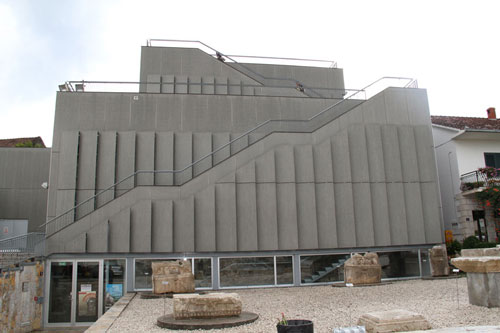
Exterior façade of the Archaeological Museum of Narona, Goran Rako, 2007.
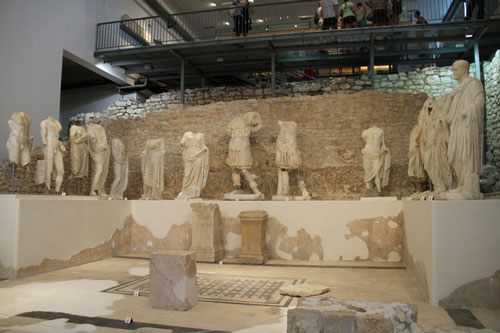
Interior, remains are the in situ Roman temple, the so-called Augusteum.
We arrived in Dubrovnik and snapped pictures of the impressive fortress walls as our coach made its way through the narrow road to our hotels for check-in. Once settled, some ventured out in to the town for dinner or rested from the long day. I took the opportunity to explore the town and lose myself amid the winding streets of the old town, taking in the spectacular sunset and running into a group of musicians singing traditional music in a café. I chose dinner at the wonderfully busy Pupo, where, in a serendipitous moment, I was seated just behind friends from our tour. We enjoyed a wonderful seafood dinner and the experience of dining on a narrow street so characteristic of Dubrovnik.
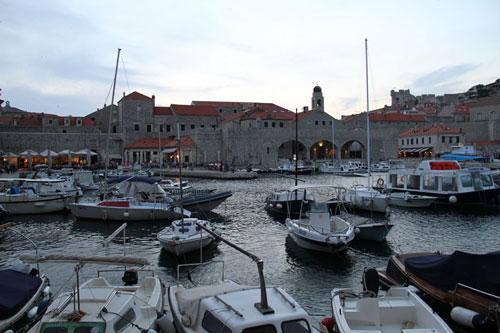
Dubrovnik’s harbor at sunset.
Dubrovnik – Friday, August 22
With a full day planned in Dubrovnik, our day began bright and early as we headed towards the old town, through its winding streets and towards Stradun Street, the main artery of old Dubrovnik and the preferred thoroughfare for strolling by locals in the cool evenings.
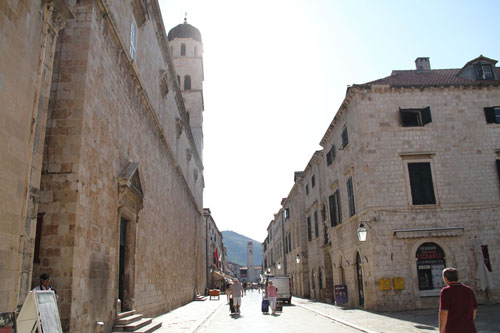
View down Stradun in the early morning before the crowds of visitors gather.
We made a quick stop at the church of the patron saint of the Dubrovnik, St. Blaise, whose church is constructed in the baroque style dating from the early 18th century. We found our way down to the famous Pile Bay, (and now immortalized in HBO’s Game of Thrones) for views of Fort Bokar and Fort Lovrijenac. The pace picked up began a walk of the old defense walls of Dubrovnik and enjoyed spectacular views of the sea, impressive fortifications, and the coastline.
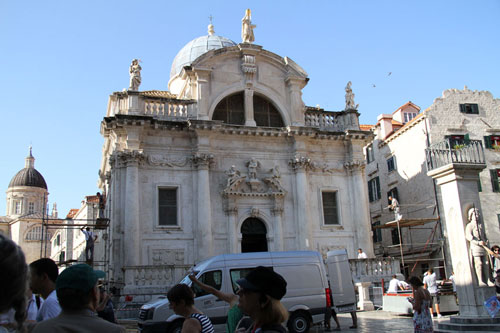
The 18th century church of St. Blaise, patron of Dubrovnik.
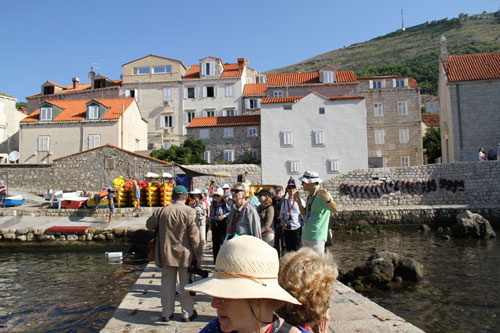
The group making its way down to Pile Bay for views towards the sea.
We returned for a discussion of the rebuilding of the harbor structure, known today as the Arsenal Tavern and City Café, envisioned by the architects Mladen Kauzlaric and Stjepan Gombos in 1932. We navigated through the crowds and made our way to the so-called Rector’s Palace, built with Gothic and Renaissance elements in its last incarnation following a fire in the 15th century. Now a museum, we explored the Palace at our own pace and then continued on the14th century Franciscan monastery that boasts one of the oldest (if not the oldest) pharmacy still in operation today.
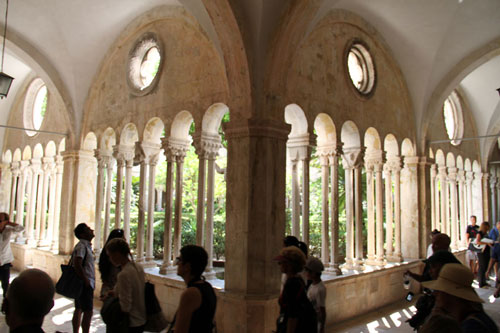
View towards the interior courtyard of the Franciscan monastery.
We broke for lunch at the charming terrace restaurant Kapon, tucked away in a quiet area away from the crowds. We rested and refreshed ourselves in the shade and I learned the hard way that if I accidentally order too much seafood (if that’s possible) it’s not actually a problem at all because I can always find friends happy to lift my burden! We wrapped up the afternoon with a visit to Dubrovnik’s cathedral of the Assumption, whose foundations have been traced to the 6th century and the Dominican monastery established in the 13th century.
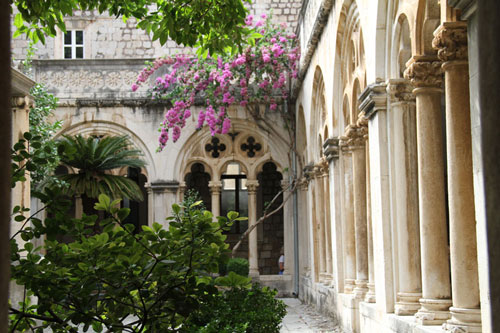
Interior courtyard views of the Dominican monastery, 13th century.
After another event filled day we headed for Gruz harbor to begin the embarkation process where we learned all about safety procedures aboard the Corinthian, our home for the next seven nights. In the evening before dinner we were treated to a lovely performance by the Klapa Poklisari. Klapa is a form of traditional music from Dalmatia that may include both instrumental and a cappella singing, and which, in 2012 came under the protection of UNESCO as an example of intangible cultural heritage.
Dubrovnik/Cavtat, Croatia and Kotor, Montenegro – Saturday, August 23
The morning began with a drive to the small town of Cavtat, a town once founded by Greek colonists in the 6th century BCE, about ten miles from Dubrovnik. Enjoying the quiet seaside promenade along the harbor we climbed up to visit the Račić Family Mausoleum by way of a sloping path through a shady grove of trees. Surrounded by a small cemetery overlooking the bay, the Račić Mausoleum is the work of 20th century Croatian artist Ivan Mestrović and includes representations of allegories and decorative elements on both the exterior and interior.
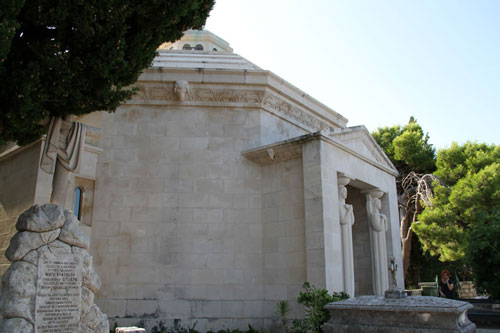
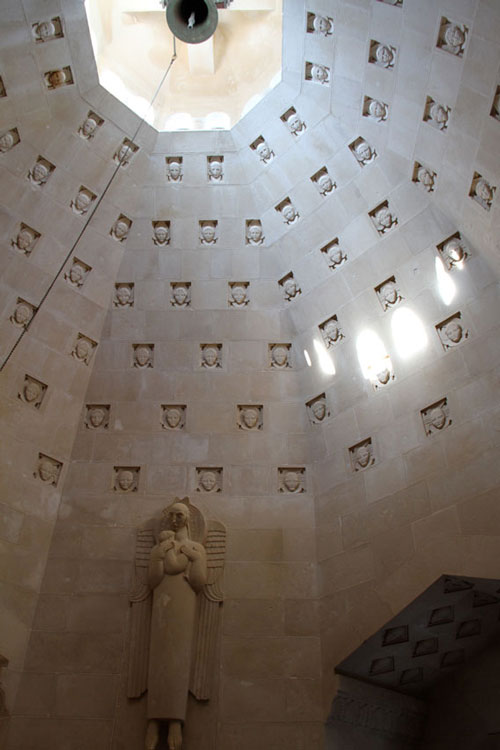
The Račić Mausoleum, exterior and interior views.
After taking some time for pictures inside the domed space, we returned to the harbor for a look at the Church of St. Nicholas, a small Baroque church whose charming stairs offered the opportunity for a discussion of alternative non-axial spaces in designs for public use.
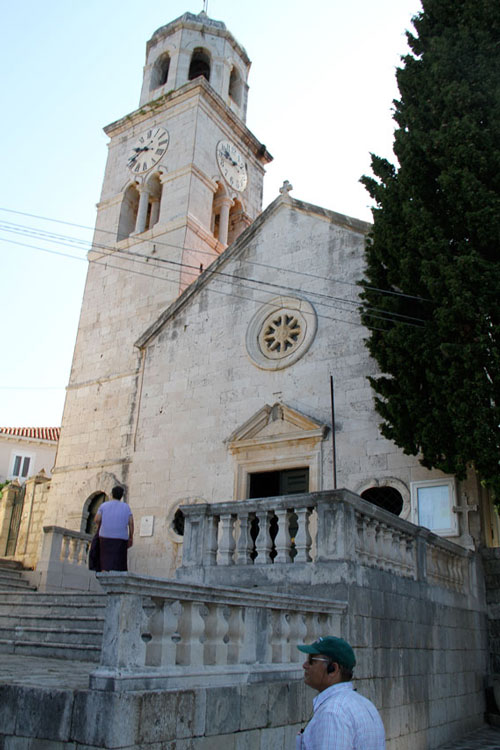
The small church of St. Nicholas, with its “waterfall” staircase.
We returned to our coach for the scenic overlook of Sivi Soko, where we appreciated the breathtaking views of Konavle valley. We then headed back to Gruz Harbor and prepared ourselves for our first adventure sailing with the Corinthian to Kotor, Montenegro. Aboard we attended our first lecture by our tour leader Boris Srdar, entitled “History of Dubrovnik, Pearl of the Adriatic.” Following lunch, I took in the beautiful views from the top deck of our ship as we sailed to Kotor’s Bay, or Boka Kotorska.
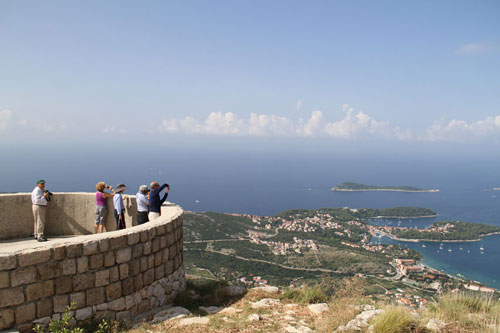
Enjoying the view at Sivi Soko.
We arrived in Kotor, a UNESCO world heritage site and began the second half of our day with our guide Miro. We entered through the so-called Sea Gate and walked into the old town, stopping at the Arms Square and the main square of the town.
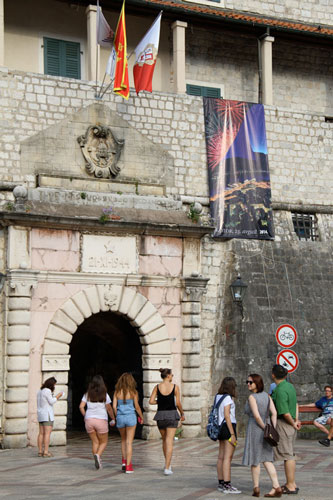
The Sea Gate of Kotor.
From Armory Square, we made a stop at the Beskuca Palace to see its façade, a building featuring a sculpted Gothic portal that once likely belonged to another family, the Bizanti.
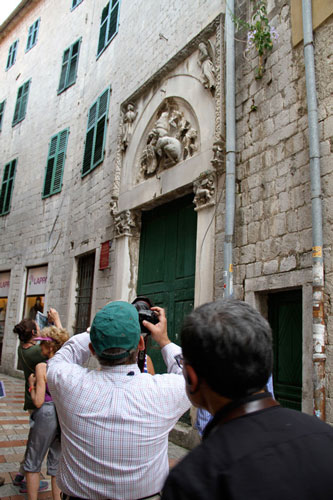
The Gothic portal at the Beskuca Palace.
With Miro leading the way, we continued through Flour Square, so-called because of the many flour storage areas that were once found there to get a view of the Pima Palace, featuring an impressive arcaded façade and loggia.
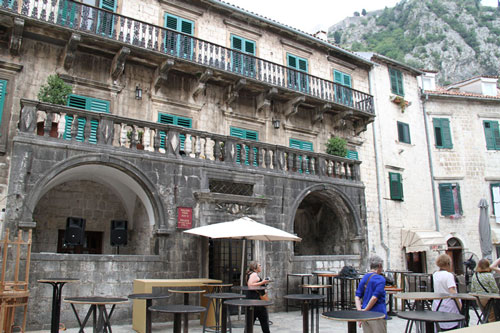
The façade of the Pima Palace.
We made a brief stop at the town’s lapidarium, where the oldest artifacts from the area are held, including a portrait of the Roman Emperor Domitian, and then headed to see the Church of Sveti Luka (St. Luke), dating from the 12th century with Romanesque and Byzantine elements, and the Catholic Church of St. Mary, dating from the 13th century. We concluded the tour with a look at the Drago Palace, an aristocratic home from the 14th and 15th centuries built over an earlier 12th century structure and a visit to the stunning St. Tryphon Cathedral, rising up against the impressive mountains.
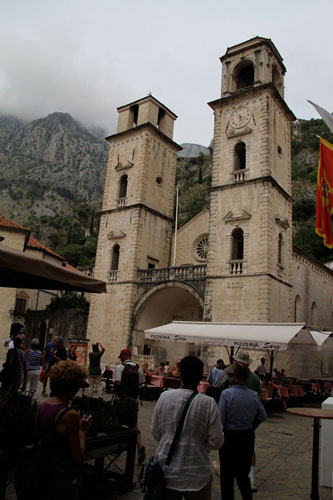
The Cathedral of St. Tryphon.
We returned to our ship for a bit of free time and had the fortunate opportunity to watch the annual festival of Boka Bay celebrating the end of summer known as the Bokelijska Noc from the deck of the ship. The celebration carried on with music, floats in the bay and fireworks. We said good-bye to lovely Kotor and set off for our next stop, the island of Korcula.
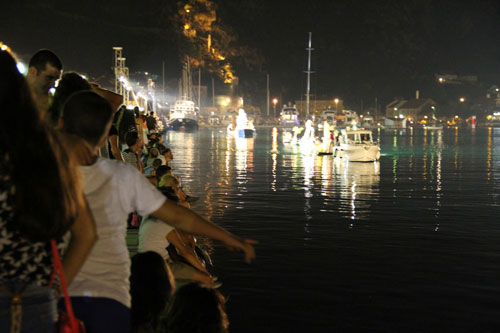
Festivities along the bay of Kotor.
Korcula – Sunday, August 24
We arrived in Korcula in the morning and met our guide, Stanka. We headed to the old town, which is laid in a herringbone pattern and preserves a distinct Venetian presence in the architecture. Our first stop was the Cathedral of St. Mark (Sveti Marko), built with both Gothic and Renaissance elements in the 15th century. St. Mark serves as an interesting case study because it is built with non-parallel walls, causing the ceiling to appear to slant. We spent some time in the cathedral’s accompanying square, from which we viewed the house that is believed to have once belonged to the family of Marco Polo and planned to open in the near future as a museum.
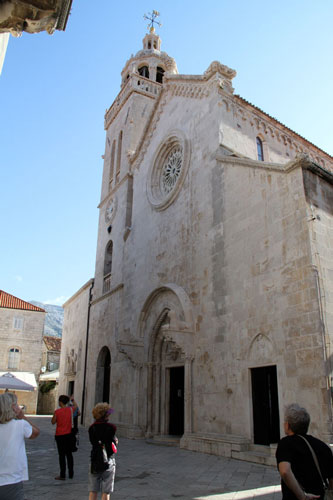
The façade of the Cathedral of St. Mark.
In St. Mark’s Square we also visited the Town Museum, housing much of the town’s historical material dating back as far as antiquity when both Illyrians and later, Greek colonists established themselves on the island. The museum was originally built as a palace in the 15th century and preserved a traditional kitchen. According to custom these were typically located on the top floor of houses to minimize damage caused by kitchen fires. Next we took a look at the historic Bishop’s Palace and treasury, the site of the bishop’s palace since beginning in the 14th century featuring a long and distinct balcony on its main façade.
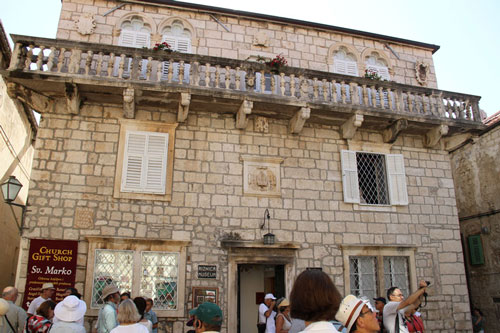
The Bishop’s palace, façade.
Our final stop with our guide was a look at the Church of All Saints, and an introduction to the history of the All Saints Brotherhood, the oldest brotherhood on the island and the Icon Museum, featuring a number of exquisite Byzantine icons as well as other icons brought back by sailors from the Mediterranean in the 17th and 18th centuries.
Following our visit to the old town, we embarked our coach for a visit to the Milina-Bire Winery where our host, Frano, welcomed us into his beautiful home and vineyard. We eagerly sampled the house wines, the dry white and the aromatic and flavorful red Plavac Mali, and enjoyed some snacks and great conversation. We said good-bye to the household goats and headed back for lunch aboard the Corinthian.
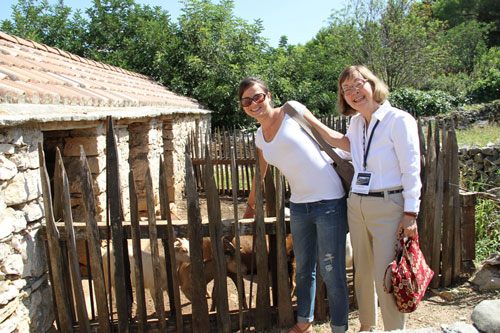
At Milina-Bire winery, saying hello to the goats.
The afternoon was left open for free time, with Boris leading a tour to see some of the other sites in town. Others had the option of either a kayak tour, a bike tour, or independent exploration of the town.
Ploce – Monday, August 25
The day began with adventure. We left early in the morning from Korcula and arrived in Ploce to embark for a drive to Mali Ston, (Little Ston) renown for its oyster farms. We boarded a small boat to reach a floating oyster farm, where our hosts gathered up fresh oysters and prepared them for us to try with wine and bread.
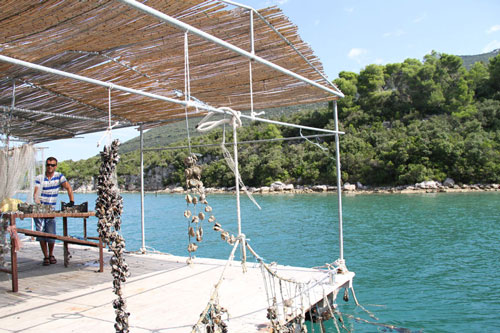
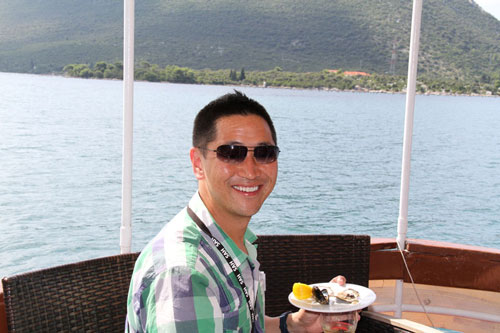
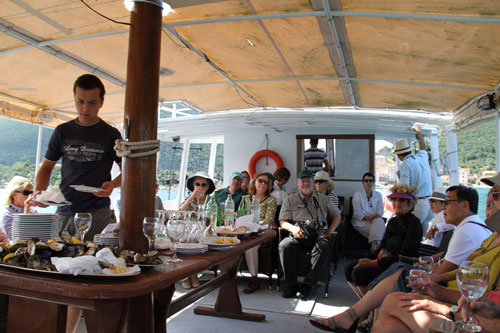
Arriving at the floating oyster farm, Ken Oshima and the group aboard the boat.
The morning boat ride and fresh oyster tasting was just the beginning of our culinary experience for the day. We boarded the coach and headed for our next stop, the Vukas Winery, to sample their household production. The hosts were welcoming and generous, serving rounds of cheese, homemade liqueurs and cured meats. From the Winery we made our way to the town of Ston, and continuing our adventure, climbed the high city defense walls began in the 14th century and affectionately called the “European Wall of China,” to take in the panoramic views of the salt pans and surrounding bay.
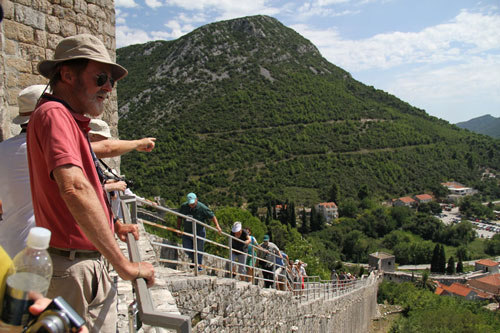
Trekking the walls of Ston.
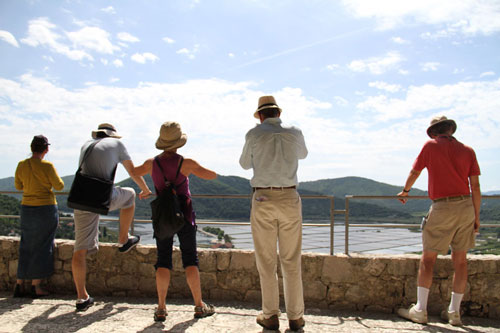
Enjoying the panoramic view and the salt pans in the distance.
We returned to the town of Ston for lunch at Stagnum a restaurant named for ancient name of Ston. Here we observed the chef use the unusual tool for keeping the coals of his grill hot – a hairdryer! We returned to Ploce that afternoon, boarded our ship and headed for the island of Hvar. En route to Hvar, we attended Boris Srdar’s second lecture entitled “Layers of Civilization – From Rome to the Present” focusing on the imprints of past cultures and the continuation of these traces into later periods. In the evening climbed to the top deck for some guided stargazing.
Hvar – Tuesday, August 26
We arrived in Stari Grad, Hvar, once settled by Greek colonists from the island of Paros. We explored the main town and enjoyed the highlight of the visit, the house of Petar Hektorović, the 16th century poet and humanist. Although unassuming from its exterior, the palace boasted a quiet garden and a spectacular fishpond.
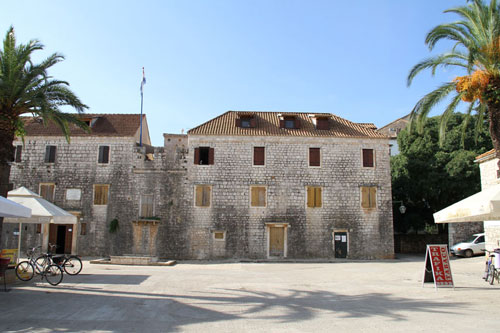
Exterior view of the Hektorović home.
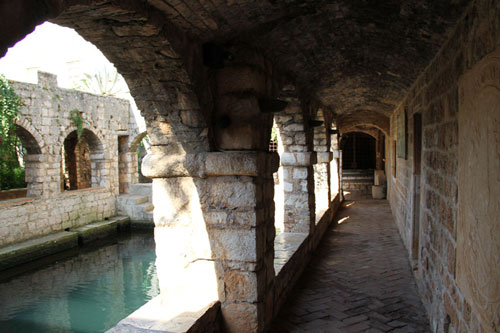
Interior view with fishpond.
We boarded our coach and drove past the Starigrad Plain, declared a UNESCO site and important for its preservation of the ancient Greek system of land parceling using stone walls as boundary markers. Our next stop was the impressive and rare architecture of St. Mary’s Church Fortress in the quaint fishing town of Vrboska, founded in the 15th century. The church of St. Mary is significant for its reconstruction in the 16th century following an Ottoman attack when it was fortified with heavy walls. We then climbed to the roof for a better appreciation of the vantage points it offered over the surrounding area.
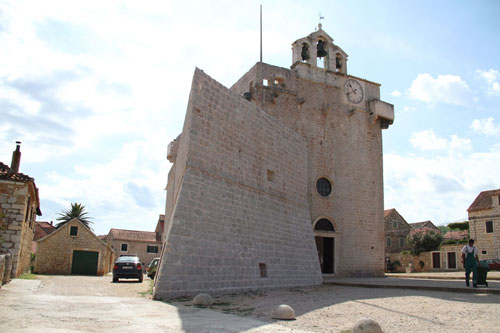
The Church Fortress of St. Mary.
After lunch we headed to the so-called Spanjola Fortress. Walking along its massive walls, we appreciated the views of Hvar and the neighboring Pakleni Islands and then headed back down to Hvar for a walking tour of the town and a stop in the St. Stephen Cathedral Square. At the Benedictine convent and church of St. Anthony the Abbot, dating from the 17th-18th century, we had the chance to appreciate the intricate and delicate designs produced by the Benedictine nuns who are well known for their lace work made from the agave plant.
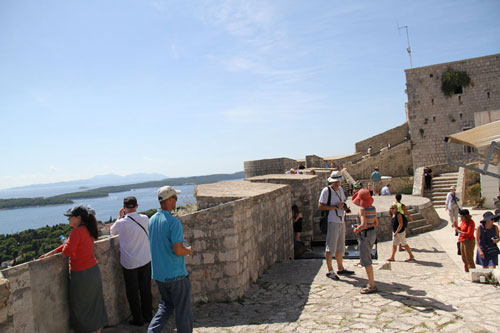
The ramparts of the Spanjola Fortress.
We returned to the main square for a visit of Hvar’s arsenal and an exquisitely restored theater dating from the 17th century, located on the second floor above the arsenal. We enjoyed a bit of free time at some of the harbor shops picking up lavender, one of Hvar’s most known local products.
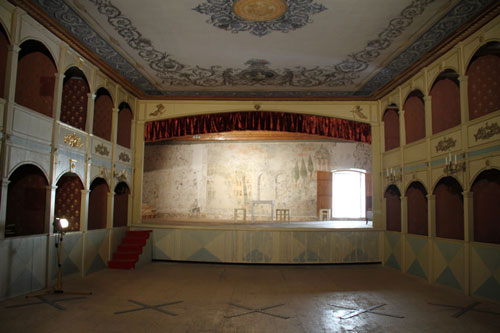
The restored theater dating from the 17th century.
Following our meet up we returned to Stari Grad, and headed for Split where we docked overnight.
Trogir and Split – Wednesday, August 27
The morning began with a visit to the town of Trogir, a small town with narrow winding streets so characteristic of the Dalmatian coast old towns. We visited the main square, known as the Square of St. Lawrence Cathedral where we happened upon another performance of klapa music. In St. Lawrence proper, first built in the 12th century and featuring both Romanesque and Gothic elements, we visited the cathedral’s baptistery, and a side chapel dedicated to St. John the Blessed. A local artist and architect, known as the Master Radovan, is credited with the construction of the west portal, which also serves as the main entrance to the cathedral.
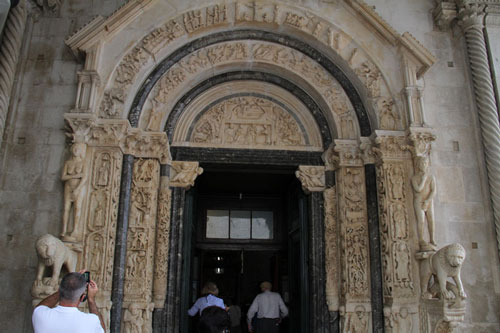
The decorated doorway to St. Lawrence Cathedral
Continuing with our walking tour, we visited the somewhat hidden church of St. Barbara built in the 9th century, a recently renovated pre-Romanesque small nave and double aisled church.
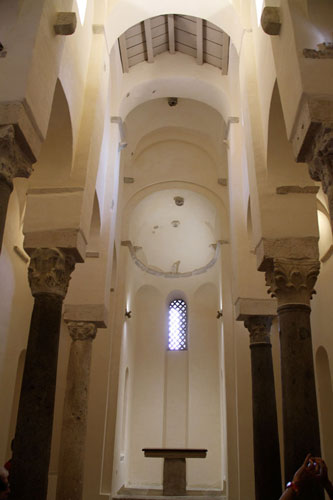
The nave and side-aisles inside the church of St. Barbara.
We headed for the bus and continued to one of the most charming places on the tour, the Mestrovic gallery and former home of the artist Ivan Mestrović. The museum features many examples of his work in different media including cast bronze and wood. Here, some chose to continue to explore the grounds independently or walk down to a chapel (the Mestrović chapel) famous for the artist’s carved wood panels. The visit continued with a stop at the Museum of Croatian Archaeological Monuments, an example of 20th century design by the architect Mladen Kauzlarić and which is primarily dedicated to the material culture of Croatia from the Middle Ages.
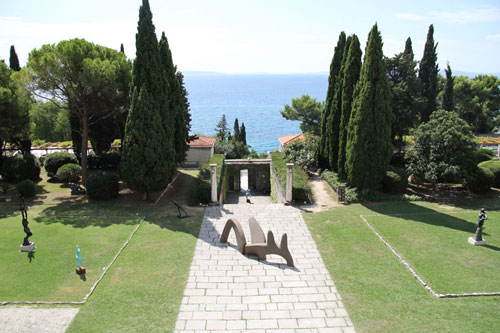
The view from the Mestrović museum and former home of the artist.
Following our lunch, we headed to Diocletian’s Palace in Split built in the 4th century CE. Although a UNESCO heritage site, Diocletian’s Palace is famous for being a “living” archaeological site, meaning that it continues to serve as a site of residence for inhabitants to this day.
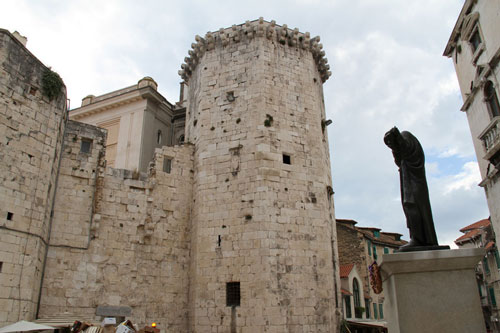
Inside the walls of Diocletian’s Palace, with a view of the 15th century Marina tower.
We were introduced to the site’s specialist, Katja Marasović from the University of Zagreb, who gave us the introductory lecture on the excavations of the site. Afterwards, we proceeded with a walking tour of the site along the North Wall, and a visit to the tiny church of St. Martin, to illustrate the adaptation of the site to later purposes. We made a stop to the city museum and viewed what is believed to have served as Diocletian’s dining table.
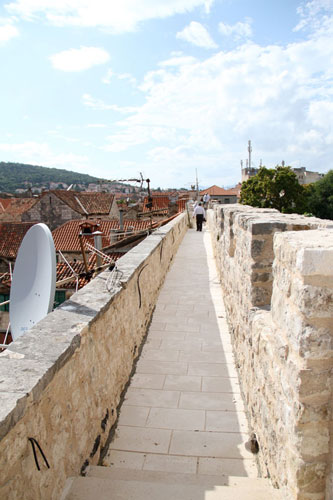
Along the North wall of the Palace.
Katja continued with the tour of the ancient historical complex of the site. We visited the domed Mausoleum of Diocletian, later converted into the Cathedral of St. Domnius, and the Temple of Jupiter. We passed through the main peristyle court, where it is believed Diocletian appeared to his audiences. We continued with a visit down to the substructure of the palace. This subterranean level features vaulted ceilings and is well preserved due to large amounts of refuse built up over past centuries, and that had helped preserve its foundations. This underground floor plan has also been used to determine the plan of the palace complex above ground.
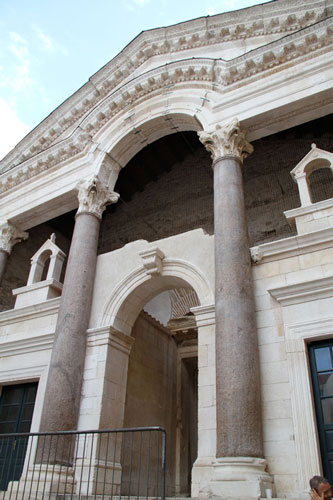
View from the peristyle court, towards the main arch.
We left for Split that evening and headed for the island of Rab and attended our last lecture by Boris Srdar, “Creating an Authentic Sense of Place.”
Rab Island – Thursday, August 28
We began our journey through the Kornati islands and arrived on Rab to begin our walking tour after lunch. We met our guide and began in the city park, continuing on to the Main Square and the Ducal Palace. We passed through the major sites of the town, including the Cathedral and the Benedictine Monastery. Since it was one of our last opportunities to photograph as a group, we assembled among the ruins of the church of St. John the Evangelist, whose original church was built in the 5th century, with later additions in the 11th century.
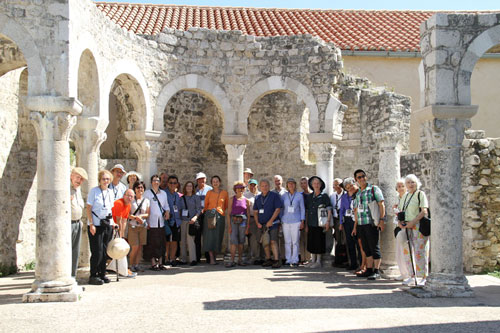
Group photo among the ruins of the church of St. John.
Our final stop on Rab was a short drive to the Franciscan monastery of St. Euphemia, dating to the 15th century. We returned to the old town of Rab, while a small group decided to climb a portion of the city walls and see the beautiful view above the rooftops. The rest of the day was spent with free time, and some opted for one last swim in the clear blue waters.
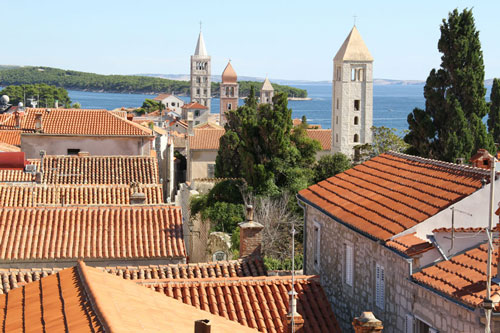
Beautiful views of Rab’s old town.
Our last night aboard the Corinthian, we attended the farewell captain’s dinner.
Venice – Friday, August 29
We sailed towards San Basilio Maritime Station, and the early risers came above deck to watch a spectacular sunrise over Venice.
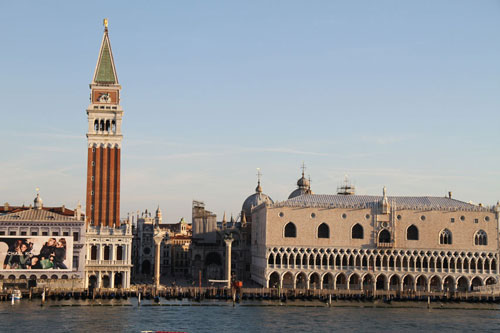
The view of Piazza San Marco from the deck of the Corinthian at sunrise.
At disembarkation, we said some final good-byes to friends made along the way and to those participants not joining along on the extension trip. We each made our way into the city to our various hotels and enjoyed the sites of the city independently.
Venice – Saturday, August 30
Our study tour day began in the Giardini with an overview of this year’s Biennale by tour leader Ken Oshima. This year’s Biennale, entitled “Fundamentals,” represents an exploration of the basic building blocks of architectural design, that is to say, the windows, doors, walls, etc. that are essential to any structure. After an overview of the exhibition and national pavilions, we began exploring the pavilions at our own pace and then transferred over to the Arsenale venue. At the Arsenale, we bee-lined for the Croatian pavilion, where we were able to revisit a few of the structures we had visited or discussed on our tour, but in model form.
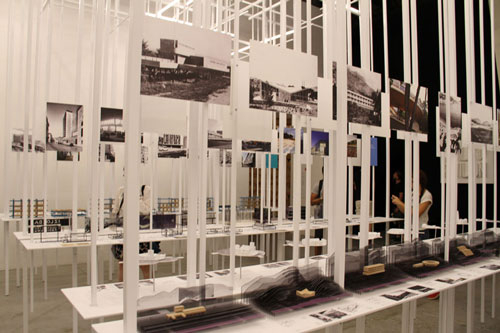
The Croatian Pavilion at the 2014 Venice Biennale.
As our tour came to an end under the arches of the Arsenale, we said our final goodbyes and expressed warm wishes to our friends.
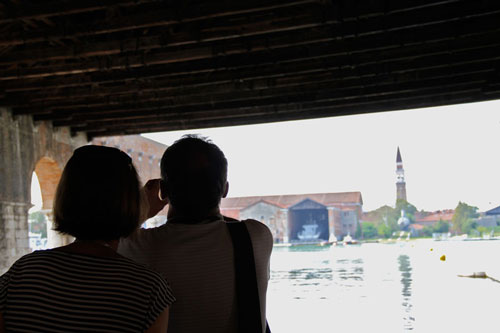
Boris and Franica Srdar catching the great view at the Venice Arsenale.
Thank you to the SAH, the Scott Opler Endowment for New Scholars, our tour leaders Boris Srdar and Ken Oshima and all the participants who helped make this time together enriching. I am grateful to have had the opportunity to grow as a person and a scholar by sharing in this experience with you.
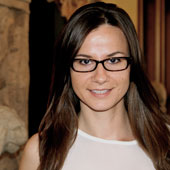 Ana M. Mitrovici, Ph.D. Candidate, University of California, Santa Barbara
Ana M. Mitrovici, Ph.D. Candidate, University of California, Santa Barbara
Ana Mitrovici is a Ph.D. candidate in the department of History of Art and Architecture at the University of California, Santa Barbara. She received her B.A. in Classical Studies and French from Concordia College, MN, and a master’s degree from UCSB. Her dissertation examines cultural exchange, healing, and the interaction of the natural and built environment in the Roman province of Dacia. She is currently the recipient of the University of California Humanities Research Institute Andrew Vincent White and Florence Wales White Fellowship for 2014-2015, funding that supports research in the humanities and medicine.



0 Leave a comment
Leave a commentOrder by
Newest on top Oldest on top